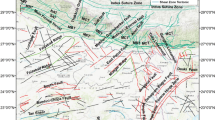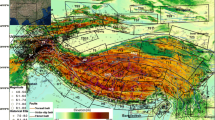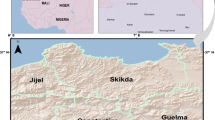Abstract
An instrumental earthquake catalog covering the time span between 1903 and 2007 and for the area bounded by 32°N–38°N and 35°E–43°E has been compiled in this research. The catalog has a magnitude of completeness (M c ) with 3.5. Least squares and statistical probability Gumbel’s techniques with different approaches have been applied on the instrumental events in order to assess the average recurrence time periods for different earthquake magnitudes. The constants a and b of Gutenberg-Richter and the average recurrence times have been computed firstly for the study area and secondly for the central and northern parts of Dead Sea fault system. The different statistical computations using Knopoff and Kagan formalism are generally in agreement and suggest an average recurrence time of 203 years for an earthquake of magnitude 7 for the region. The occurrence of large well-documented historical earthquakes in Lebanon and western Syria, the existence of active fault segments, the absence of large earthquakes during the study period, the increasing number of the low-magnitude earthquakes, and the continued accumulation of the strain since 1900 indicate therefore the probability of an earthquake occurrence of a large magnitude. This should be permanently taken into consideration in seismic hazard assessment on the local and regional scales.






Similar content being viewed by others
References
Abdul-Wahed MK, Al-Tahhan I (2010) Preliminary outline of the seismically active zones in Syria. Ann Geophys 53:1–9. doi:10.4401/ag-4683
Akyus HS, Altunel E, Karabacak V, Yalciner CC (2006) Historical earthquake activity of the northern part of the Dead Sea fault zone, southern Turkey. Tectonophysics 426:281–293
Alchalabi A, Daoud M, Gomez F, McClusky S, Reilinger R, Abu Romeyeh M, Alsouod A, Yassminh R, Ballani B, Darawcheh R, Sbeinati R, Radwan Y, Al Masri R, Bayerly M, Al Ghazzi R, Barazangi M (2010) Crustal deformation in northwestern Arabia from GPS measurements in Syria: slow slip rate along the northern Dead Sea Fault. Geophys J Int 180:125–135
Alfonsi L, Cinti FR, Ventura G (2013) The kinematics of the 1033 A.D. earthquake revealed by the damage of Hisham palace (Jordan Valley, Dead Sea transform zone). Seismol Res Lett 84:997–1003
Al-Hariri, A.M., (1997). Seismic hazard assessment in the Syrian Arab Republic, Proc. of the Symposium “Earthquakes,” (in Arabic), pp. 99–136, University of Tishreen and Higher Council for Sciences, Latakia, Syria.
Ambraseys NN (2001) Reassessment of earthquakes, 1900–1999, in the eastern Mediterranean and the Middle East. Geophys J Int 145:471–485
Ambraseys NN, Barazangi M (1989) The 1759 earthquake in the Bekaa Valley: implications for earthquake hazard assessment in the eastern Mediterranean region. J Geophys Res 94:4007–4013
Ambraseys NN, Bommer JJ (1990) Uniform magnitude re-evaluation for the strong motion database of Europe and adjacent areas. Eur Earthq Eng 4:3–16
Ambraseys, N.N. & Finkel, C.F., (1993). Material for the investigation of the seismicity of the eastern Mediterranean region during the period 1690–1710, in Materials of the CEC Project “Review of Historical Seismicity in Europe”, pp. 173–194, ed. Stucchi, M., CNR, 1, 173–194, Milano.
Ambraseys NN, Jackson JA (1998) Faulting associated with historical and recent earthquakes in the eastern Mediterranean region. Geophy. J. Int. 133:390–406
Ambraseys NN, Melville CP (1988) An analysis of the eastern Mediterranean earthquake of 20 May 1202. In: Lee W (ed) History of seismography and earthquakes of the world. Academic Press, San Diego, pp 181–200
Asfahani J, Abdul-Wahed MK (2013) Evaluation of earthquake activity along the Serghaya Fault, Syria, from instrumental seismic data. Acta Geophys 61:37–59
Brew G, Barazangi M, Al-Maleh AK, Sawaf T (2001) Tectonic and geologic evolution of Syria. GeoArabia 6(4):573–616
Daëron M, Klinder P, Tapponnier P, Elias A, Jacques E, Sursock A (2005) Sources of the large A.D. 1202 and 1759 near east earthquakes. Geol Soc Am 33:529–532
Daoud M (1995) Features of the activity of the historical earthquakes and its temporal quiescence in Syria (in Arabic). Journal of Damascus University in Basic and Applied Sciences 11:27–43
Darawcheh R, & Sbeinati MR (1995) Earthquakes in and around Syria during 1995 (in Arabic), Internal report, Atomic Energy Commission of Syria, Damascus, 7 p.
El Ssayed HM, Zaineh HE, Dojcinovski D, Mihailov V (2012) Re-evaluations of seismic hazard of Syria. Int J Geosci 3:847–855. doi:10.4236/ijg.2012.324085
Elnashai AS, & El-Khoury R (2004) Earthquake hazard in Lebanon. Imperial College Press.
Gomez F, Meghraoui M, Darkal AD, Hijazi F, Mouty M, Suleiman Y, Sbeinati R, Darawcheh R, Al-Ghazzi R, Barazangi M (2003) Holocene faulting and earthquake recurrence along the Serghaya branch of the Dead Sea fault system in Syria and Lebanon. Geophy. J. Int. 153:658–674
Gomez F, Karam G, Khawlie M, McClusky S, Vernant P, Reilinger R, Jaafar R, Tabet C, Khair K, Barazangi M (2007) GPS measurements of strain accumulation and slip transfer through the restraining bend along the Dead Sea fault system in Lebanon. Geophy J Int 168:1021–1028
Guidoboni E, Comastri A, Traina G (1994) Catalogue of ancient earthquakes in the Mediterranean area up to the tenth century. Istituto Naz. di Geofisica, Rome
Gumbel EJ (1958) Statistics of extremes. Columbia University Press, New York
Gutenberg B, Richter CF (1944) Frequency of earthquakes in California. Bulletin Seismological Society of America 34:185–188
Imam MA, Al-Hakim K (1988) Historical seismicity in Syria, (in Arabic). Journal of Geological Sciences 2:24–40
International Seismological Center (ISC) On-line ISC bulletin. http://www.isc.ac.uk. Thatham, United Kingdom. Last access August 2016.
Knopoff L, Kagan Y (1977) Analysis of the theory of extremes as applied to earthquake problems. J Geophys Res 82:5647–5657
Makropoulos KC, Burton PW (1981) A catalogue of seismicity in Greece and the adjacent areas, Geophys. J.R. Astr Soc 65:741–762
Matar A (1997) Earthquake probability and seismotectonics, Proc. of the Symposium “Earthquakes”, (in Arabic), pp. 59–76, University of Tishreen and Higher Council for Sciences Publication, Latakia, Syria.
Meghraoui M, Gomez F, Darkal AN, Hijazi F, Mouty M, Suleiman Y, Sbeinati R, Darawcheh R, Al-Ghazzi R, Barazangi M (2003) Evidence for 830 years of seismic quiescence from palaeoseismology, archaeoseismology and historical seismicity along the Dead Sea fault system in Syria, Earth Planet. Sc Lett 210:35–52
Mohamed AE, El-Hadidy M, Deif A, Abou Elenean K (2012) Seismic hazard studies of Egypt. NRIAG Journal of Astronomy and Geophysics 1:119–140
Nemer T, Meghraoui M (2006) Evidence of coseismic ruptures along the Roum fault (Lebanon): a possible source for the AD 1837 earthquake. J Struct Geol 28:1483–1495
Plassard J, Kogoj B (1981) Séismicité du Liban: Catalogue des séismes ressentis, 3e édition. CNRS, Bierut
Poirier JP, Romanowicz BA, Taher MA (1980) Large historical earthquakes and seismic risk in northwest Syria. Nature 285:217–220
Sbeinati MR, Darawcheh R, Bayerly M, Makris J, & Stäcker J (2001) A microseismicity survey of the Latakia district, Syria, (in Arabic), unpublished report, AECS-G\RSS 390, Damascus.
Sbeinati MR, Darawcheh R, Mouty M (2005) The historical earthquakes of Syria: an analysis of large and moderate earthquakes from 1365 B.C. to 1900 A.D. Ann Geophys 48:347–435
Westaway R (2004) Kinematics consistency between the Dead Sea fault zone and the Neogene and quaternary left-lateral faulting in SE Turkey. Tectonophysics 391:203–237
Acknowledgements
Prof. I. Othman, Director General of the Atomic Energy Commission of Syria, is thanked for his permission to publish this research work. Special thanks are due to the two anonymous reviewers for their constructive criticisms and their efforts to improve the final version of this research. This work is a scientific research no. AECS-G\FRSR/479/2010.
Author information
Authors and Affiliations
Corresponding author
Rights and permissions
About this article
Cite this article
Asfahani, J., Darawcheh, R. Seismicity assessment in and around Syria based on instrumental data: application of Gumbel distributions and Gutenberg-Richter relationship. Arab J Geosci 10, 86 (2017). https://doi.org/10.1007/s12517-017-2862-y
Received:
Accepted:
Published:
DOI: https://doi.org/10.1007/s12517-017-2862-y




